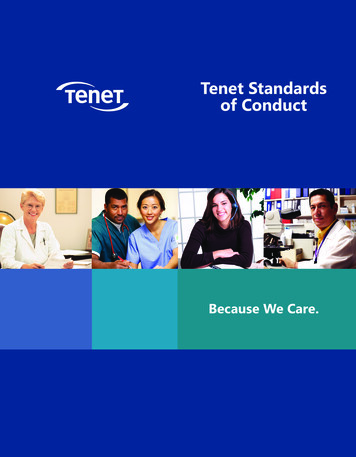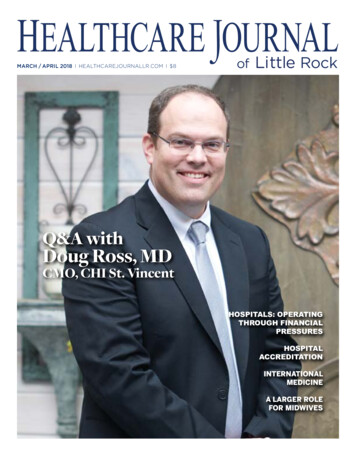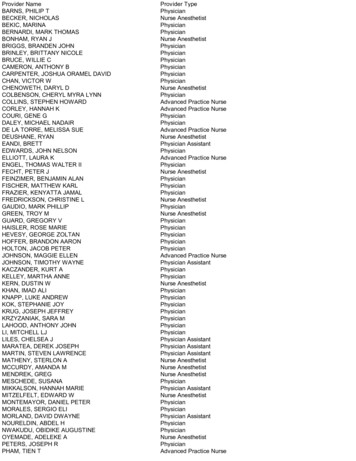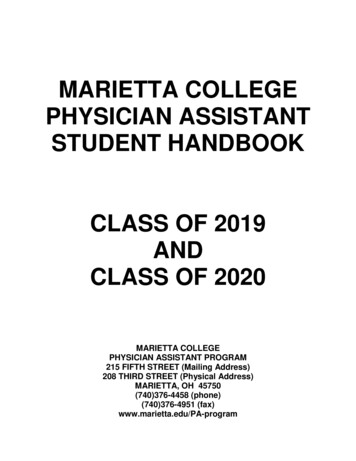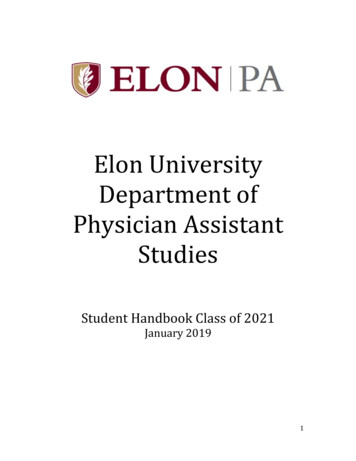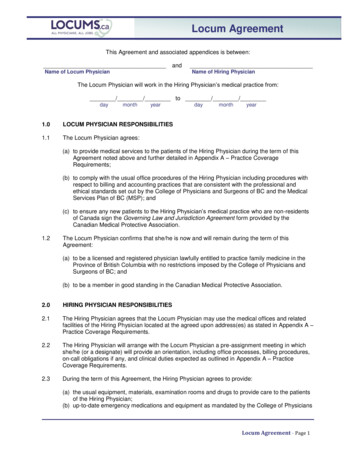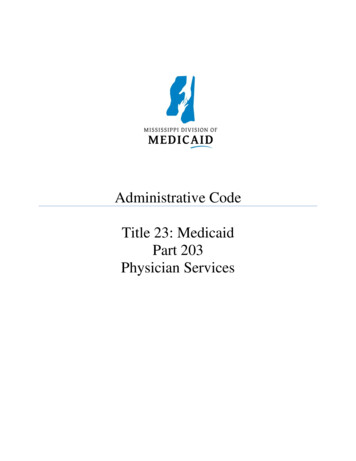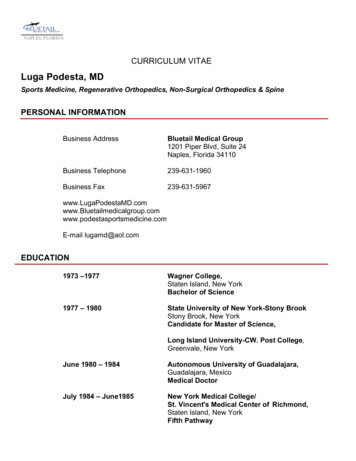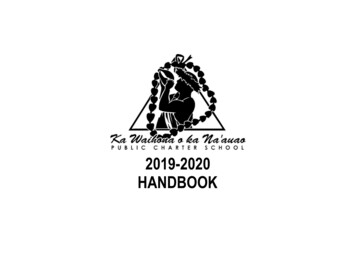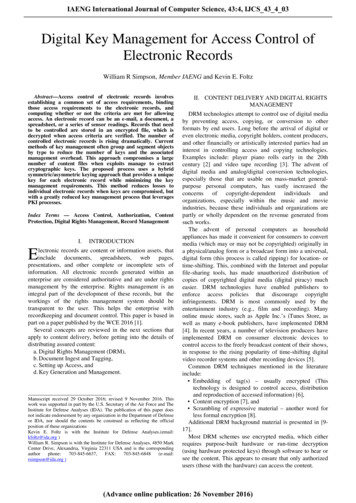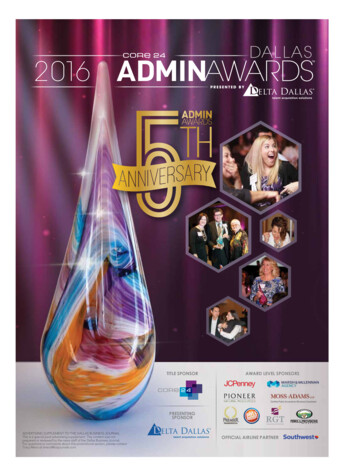
Transcription
Tenet Physician ResourcesPolicies and ProceduresTitle:WORKPLACE SAFETYI.No.:TPR.CQM.111.00Page:1 of 8Effective Date:06-01-16Retires Policy Dated:Previous Versions Dated:SCOPE:This policy applies to all physician practices owned or operated by Tenet HealthcareCorporation’s consolidated subsidiaries (each, a “Tenet Physician Practice”).II.PURPOSE:The purpose of this policy is to define the requirements for a safe work environment, andestablish the expectation that it is the responsibility of all personnel to create and maintain a safework environment, and to follow procedures to support workplace safety.III.DEFINITIONS:Universal Precautions – “Universal Precautions is an approach to infection control to treat allhuman blood and certain human body fluids as if they were known to be infectious for HIV,HBV and other bloodborne pathogens”1Bloodborne Pathogens Standard (BBP) – requires: “Employees to observe Universal Precautions to prevent contact with blood or otherpotentially infectious materials (OPIM). Under circumstances in which differentiation between body fluid types is difficult orimpossible, all body fluids shall be considered potentially infectious materials. Treat all blood and other potentially infectious materials with appropriate precautionssuch as:Use gloves, masks, and gowns if blood or OPIM exposure is anticipated.Use engineering and work practice controls to limit exposure.”2Standard Precautions – “Recommended by the Centers for Disease Control (CDC) for the careof all patients, regardless of their diagnosis or presumed infection status. 12Standard Precautions apply to 1) blood; 2) all body fluids, secretions, and excretions,except sweat, regardless of whether or not they contain visible blood; 3) non-intact skin;and 4) mucous membranes. Standard precautions are designed to reduce the risk oftransmission of microorganisms from both recognized and unrecognized sources ofinfection in hospitals.29 CFR 1910.1030(b), see univprec/univ.html29 CFR 1910.1030(d)(1), see univprec/univ.html
Tenet Physician ResourcesPolicies and ProceduresTitle:WORKPLACE SAFETY No.:TPR.CQM.111.00Page:2 of 8Effective Date:06-01-16Retires Policy Dated:Previous Versions Dated:Standard Precautions includes the use of: hand washing, appropriate personal protectiveequipment such as gloves, gowns, masks, whenever touching or exposure to patients'body fluids is anticipated.”3Transmission-Based Precautions – “(i.e., Airborne Precautions, Droplet Precautions, andContact Precautions) are recommended to provide additional precautions beyond StandardPrecautions to interrupt transmission of pathogens in hospitals.Transmission-based precautions can be used for patients with known or suspected to be infectedor colonized with epidemiologically important pathogens that can be transmitted by airborne ordroplet transmission or by contact with dry skin or contaminated surfaces. These precautionsshould be used in addition to standard precautions. Airborne Precautions used for infections spread in small particles in the air such as chickenpox. Droplet Precautions used for infections spread in large droplets by coughing, talking, orsneezing such as influenza. Contact Precautions used for infections spread by skin to skin contact or contact with othersurfaces such as herpes simplex virus.”4Sharps – objects that can penetrate the skin, such as needles, scalpels, broken glass, capillary tubesand the exposed ends of dental wires. If blood or other potentially infectious materials are presentor may be present on the sharp, it is a contaminated sharp and appropriate protective measures mustbe taken.Exposure Control Plan – a document to assist the Physician Practice in implementing andensuring compliance with the Occupational Safety & Health Administration (OSHA) Standard 29CFR 1910.1030, “Occupational Exposure to Bloodborne Pathogens.”Personal Protective Equipment (PPE) – Protective equipment for eyes, face, head, andextremities; protective clothing such as gloves and gowns; respiratory devices; and protectiveshields and barriers used and maintained in a sanitary and reliable condition wherever it is necessaryby reason of hazards of processes or environment, chemical hazards, radiological hazards, ormechanical irritants encountered in a manner capable of causing injury or impairment in thefunction of any part of the body through absorption, inhalation, or physical contact.Hand hygiene - means hand washing, antiseptic hand wash, antiseptic hand rub or iv.html
Tenet Physician ResourcesPolicies and ProceduresTitle:WORKPLACE SAFETYNo.:TPR.CQM.111.00Page:3 of 8Effective Date:06-01-16Retires Policy Dated:Previous Versions Dated:Alcohol-based hand rub - means an alcohol-containing preparation designed for application tothe hands for reducing the number of viable organisms on the hands. In the United States, suchpreparations usually contain 60% to 95% ethanol or isopropanol.Antimicrobial Soap - means soap (i.e., detergent) containing an antiseptic agent such aschlorhexidine, PCMX, hexachlorophene, iodophors or triclosan.Antiseptic Agent - means an antimicrobial substance that is applied to the skin to reduce thenumber of microbial flora. Examples include alcohol, chlorhexidine, chlorine, hexachlorophene,iodine, chloroxylenol and triclosan.Decontaminate - means to reduce bacterial counts on hands by performing antiseptic hand rubor antiseptic hand wash.Plain Soap - means detergents that do not contain antimicrobial agents.Visibly Soiled Hands - mean hands showing visible dirt or visibly contaminated withproteinaceous material, blood or other body fluids (e.g., fecal material or urine).Artificial nails - means any material applied or added to natural nails to augment or enhance(strengthen and lengthen) the wearer’s own fingernails, including wraps, acrylics, extenders,overlays, gels and gel polish, tips, and any item that is glued or pierced through the nail.5Natural nails - means nails without artificial covering other than fresh nail polish. No glitter orstickers on the nails.Nail polish - means nail polish that is not obviously chipped or worn.6 Polish must be able to beremoved by the individual immediately in case of an emergency.Healthcare providers and workers - mean all paid and unpaid persons working in healthcaresettings who have the potential for exposure to infectious materials, including contaminated medicalsupplies. Healthcare providers might include, but are not limited to: physicians, nurses,nursing/medical assistants/coordinators, therapists, technicians, emergency medical servicepersonnel, dental personnel, pharmacists, pharmacy personnel, laboratory personnel, autopsypersonnel, students and trainees, contractual staff and persons, i.e., clerical, dietary, housekeeping,maintenance and volunteers not directly involved in patient care but potentially exposed to infectiousagents that can be transmitted to and from the healthcare provider.7Hazard Communication Standard or HazCom – The purpose of the Standard is to ensurechemical safety in the workplace by requiring information about the identities and hazards of thechemicals be available and understandable to workers. The Standard sets forth requirements for5AORN, 2009 Standards, Recommended Practices, and GuidelinesAORN, 2009 Standards, Recommended Practices, and Guidelines7APIC and the Healthcare Infection Control Practices Advisory Committee (HICPAC) statement, published inFebruary 20066
Tenet Physician ResourcesPolicies and ProceduresTitle:WORKPLACE SAFETYNo.:TPR.CQM.111.00Page:4 of 8Effective Date:06-01-16Retires Policy Dated:Previous Versions Dated:chemical manufacturers and importers, “to evaluate the hazards of the chemicals they produce orimport, and prepare labels and safety data sheets to convey the hazard information to theirdownstream customers. All employers with hazardous chemicals in their workplaces must havelabels and safety data sheets for their exposed workers, and train them to handle the chemicalsappropriately.”8Safety Data Sheets or SDS – formerly Material Safety Data Sheets or MSDS. “The HazardCommunication Standard (HCS) requires chemical manufacturers, distributors, or importers toprovide Safety Data Sheets (SDS) (formerly known as Material Safety Data Sheets or MSDS) tocommunicate the hazards of hazardous chemical products. As of June 1, 2015, the HCS willrequire of manufacturers that the new SDS be in a uniform format, and include the sectionnumbers, the headings, and associated information under the headings.”9 Practices must have thenew SDS on site by June 1, 2016.Hazardous Chemical – a chemical that presents a physical hazard, a health hazard, or both.10Exempt Product – a consumer product used as a consumer would at home for the same purpose,for the same duration of time, and the same frequency of use. SDS may be maintained for exemptproducts even though not required.For the purpose of licensing and regulating liquid products used as disinfectants that are sold ininterstate commerce in the United States, the U.S. Environmental Protection Agency (EPA)defines the following:Sterilization – The complete destruction or removal of all microorganisms, including spores.Disinfection – A process which kills specified “pathogens”, except spores, on inanimate surfacesusing standardized laboratory testing procedures. Disinfection may also be defined as the virtualelimination of all harmful microorganisms, except spores, in an attempt to prevent transmissionof disease.Sanitization – Generally refers to chemical treatment, often with emphasis on good detergentcleaning, to reduce microbial contamination on surfaces somewhat less effectively thandisinfection.Decontamination – Disinfection or other process that renders contaminated items safe to handlewith reasonable care, such as a first process employed when items are returned to a hospitalcentral service to protect employees from risk of tmlhttps://www.osha.gov/Publications/HazComm QuickCard SafetyData.html1029 CFR 1910.1200(c), see https://www.osha.gov/dsg/hazcom/ghd053107.html9
Tenet Physician ResourcesPolicies and ProceduresTitle:WORKPLACE SAFETYNo.:TPR.CQM.111.00Page:5 of 8Effective Date:06-01-16Retires Policy Dated:Previous Versions Dated:Antisepsis – The use of chemicals (sometimes the same chemicals used as disinfectants orsanitizers, but usually in more dilute form) in an attempt to control microorganismscontaminating skin or other living tissue.Antimicrobial – Tending to destroy microbes, prevent their development, or inhibit theirpathogenic action.Germicidal – Preventing infection by inhibiting the growth or action of microorganisms.Single-Use Device or SUD – a device that is intended for one use or use on a single patient during asingle procedure. Any product that is labeled “single use” must be disposed of after patient use.Single use products may not be cleaned and reused.Spill-Kit – kit containing necessary equipment to clean up spill.IV.POLICY:A.Universal and Standard Precautions and Exposure Control PlanThe providers and staff of the Physician Practice will establish and maintainUniversal and Standard Precautions, and other recommended work practicecontrols and safeguards to support a safe environment when providing care andservices to patients and visitors. Education and training will be provided at initialhire and annually to assure providers and staff understand and comply with therequirements of the Exposure Control Plan.The Physician Practice will adopt an Exposure Control Plan to assist in complyingwith the OSHA regulations on Bloodborne Pathogens (BBP). It is used inconjunction with the complete standard, Title 29 Code of Federal Regulations,1910.1030, or its state OSHA plan equivalent. The Physician Practice will complywith the current regulations applicable for its geographic location and specialty.The Physician Practice considers all blood and body fluids from every personpotentially infectious. The Physician Practice will take all precautions to ensurethat BBP transmission following occupational exposure, and body fluid infectionsdo not occur.B.Injection SafetyThe Physician Practice trains all providers and staff in proper use of syringes,needles, and medication vials used during routine healthcare procedures, use safepractices to minimize risk of hazards, eliminate or reduce the use of needles andother sharps, and use devices with safety features to isolate sharps (“EngineeredSharps Injury Protection”).
Tenet Physician ResourcesPolicies and ProceduresTitle:WORKPLACE SAFETYC.No.:TPR.CQM.111.00Page:6 of 8Effective Date:06-01-16Retires Policy Dated:Previous Versions Dated:Personal Protective EquipmentThe Physician Practice provides Personal Protective Equipment (PPE) for use byall employees with occupational exposure to potentially infectious materials. Inaccordance with the OSHA Personal Protective Equipment Standard 29 CFR1910.132, protective equipment, including personal protective equipment for eyes,face, head, and extremities; protective clothing; respiratory devices; andprotective shields and barriers shall be provided, used, and maintained in asanitary and reliable condition wherever it is necessary by reason of hazards ofprocesses or environment, chemical hazards, radiological hazards, or mechanicalirritants encountered in a manner capable of causing injury or impairment in thefunction of any part of the body through absorption, inhalation, or physicalcontact. The Physician Practice will provide protective equipment, including PPE,used to act in accordance with this policy at no cost to its employees.D.Hand HygieneThe Physician Practice promotes proper hand hygiene as the single mostimportant means of controlling the spread of infection and minimizing any effectsof chemical contact with skin. The Physician Practice adopts the Centers forDisease Control and Prevention (CDC) Guideline for Hand Hygiene in HealthCare Settings with enhancements from the World Health Organization (WHO)Guidelines on Hand Hygiene in Health Care. All employees will comply withhand hygiene guidelines.E.Fingernails (Artificial and Natural)The Physician Practice prohibits the wearing of artificial nails/tips/no-chip gelnails/nail jewelry for all healthcare providers and workers who may touch apatient or items a patient may use or touch.F.Respiratory Hygiene/Cough EtiquetteThe Physician Practice trains all employees in universal respiratory precautionsand etiquette, and to promote respiratory hygiene/cough etiquette to patients andvisitors.G.Hazard Communication ProgramEmployers that have hazardous chemicals in their workplace are required byOSHA’s Hazard Communication Standard (HCS), 29 CFR 1910.1200, toimplement a Hazard Communication Program. The Physician Practice willimplement a hazard communication program which will include labels oncontainers of hazardous chemicals, safety data sheets (SDSs) for hazardouschemicals, and training for workers.
Tenet Physician ResourcesPolicies and ProceduresTitle:WORKPLACE SAFETYH.No.:TPR.CQM.111.00Page:7 of 8Effective Date:06-01-16Retires Policy Dated:Previous Versions Dated:Environmental Cleaning, Decontamination and Disposal of WasteThe Physician Practice will prevent contamination and maintain appropriatelevels of cleanliness and infection control. The Physician Practice will complywith all regulations regarding disinfection and sterilization in order to preventinfections and prevent the spread of infection.V.PROCEDURE:A.Job AidThe Physician Practice will follow the procedural steps required to develop andmaintain a safe work environment as outlined in the job aids listed in thereference section of this policy. Additional Workplace Safety job aids may bedeveloped at a future date and added to this policy.B.StandardEach Tenet Region will establish, and the Physician Management ExecutiveCommittee must approve, performance standards for this policy. The policy jobaid will include the standards.C.Responsible PersonThe Physician Practice Manager or designee is responsible for ensuring that allindividuals adhere to the requirements of this policy according to the specificrequirements of their job description. If the Physician Practice Manager ordesignee identifies non-adherence to this policy, the Physician Practice Manageror designee will immediately report the non-adherence to this policy to the MarketOperations Manager or Market Operations Director or designees.D.Auditing and MonitoringThe Market Operations Director and Market/Regional Quality Manager ordesignees will audit adherence to this policy by requesting an annual review ofphysician practice compliance conducted by the Market’s approved OSHAvendor or other Tenet facility.E.EnforcementAll employees whose responsibilities are affected by this policy are expected tobe familiar with the basic procedures and responsibilities created by this policy.Failure to comply with this policy will be subject to appropriate performancemanagement pursuant to all applicable policies and procedures, up to andincluding termination. Such performance management may also include
Tenet Physician ResourcesPolicies and ProceduresTitle:WORKPLACE SAFETYNo.:TPR.CQM.111.00Page:8 of 8Effective Date:06-01-16Retires Policy Dated:Previous Versions Dated:modification of compensation, including any merit or discretionary compensationawards, as allowed by applicable d PoliciesTPR and JA.TPR.CQM.106.00 Event Reporting – Patient or VisitorJob AidsJA.TPR.CQM.111.00 Universal and Standard Precautions and Exposure Control PlanJA.TPR.CQM.111.01 Injection SafetyJA.TPR.CQM.111.02 Personal Protective EquipmentJA.TPR.CQM.111.03 Hand HygieneJA.TPR.CQM.111.04 FingernailsJA.TPR.CQM.111.05 Respiratory Hygiene/Cough EtiquetteJA.TPR.CQM.111.06 Hazard Communication ProgramJA.TPR.CQM.111.07 Environmental Cleaning, Decontamination, and Disposal of Waste
This policy applies to all physician practices owned or operated by Tenet Healthcare Corporation's consolidated subsidiaries (each, a "Tenet Physician Practice"). II. PURPOSE: The purpose of this policy is to define the requirements for a safe work environment, and establish the expectation that it is the responsibility of all personnel .
